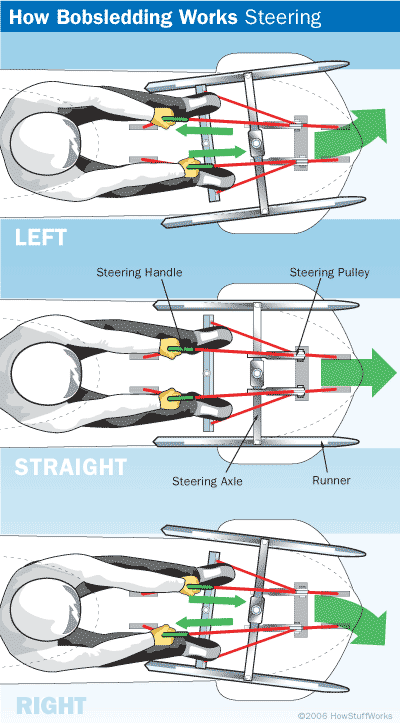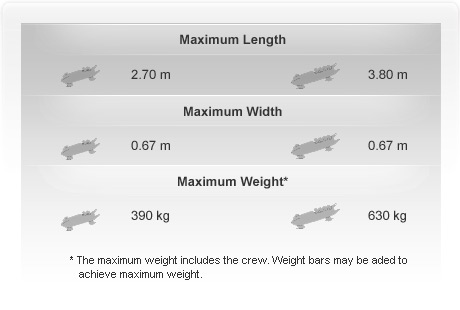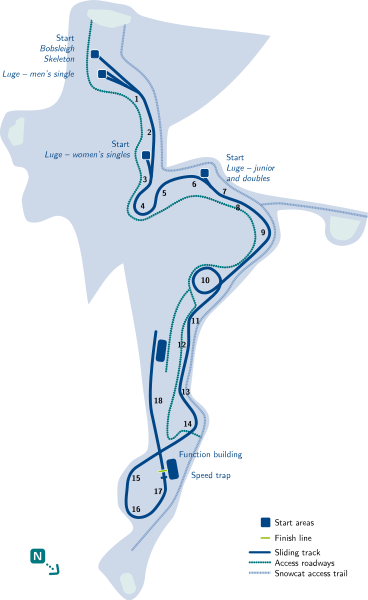
- •Lesson 3. Equipment and Tracks
- •Vocabulary
- •Exercises
- •Read the text.
- •Give Russian equivalents for:
- •Translate the following sentences into Russian:
- •Translate the following sentences into English:
- •Make a summary of the text.
- •Translate the article into English:
- •Act as interpreter:
- •Act as interpreter:
- •Glossary (Bobsleigh)
Lesson 3. Equipment and Tracks
The sled is an aerodynamic machine made of fiberglass and steel, mounted on four highly polished steel runners. The sled consists of a main hull (also known as a cowling), a frame, a front and rear axle, and two sets of independent steel runners. There's a popular misconception that runners are sharp - they are actually blunt. Sleds hydroplane across the icy track; they do not cut into it. The two front runners have approximately three inches of lateral movement and are attached to ropes or cables held by the driver, who steers the sled.
M odern
bobsleighs are steered using two metal steering
rings.
Sometimes they are called D-rings
since they have the D-shape. The rings are connected to cables which
in turn are attached to the front runners via a pulley
system.
This is all housed within the forward cowling. To steer the sled
left, the left ring is pulled toward the pilot; for turning right,
the right ring is pulled toward the pilot. Only subtle steering
adjustments are necessary to guide the sled; a slight bit too much
either way can result in a crash when traveling at speeds of 80 mph
or more. The crew also leans into curves as necessary to aid in
steering the sled.
odern
bobsleighs are steered using two metal steering
rings.
Sometimes they are called D-rings
since they have the D-shape. The rings are connected to cables which
in turn are attached to the front runners via a pulley
system.
This is all housed within the forward cowling. To steer the sled
left, the left ring is pulled toward the pilot; for turning right,
the right ring is pulled toward the pilot. Only subtle steering
adjustments are necessary to guide the sled; a slight bit too much
either way can result in a crash when traveling at speeds of 80 mph
or more. The crew also leans into curves as necessary to aid in
steering the sled.
A four-man sled is easier for a driver to control, but harder to extricate from difficult situations since the increased weight makes it less responsive than a two-man sled. If a four-man sled hits a skid, its own weight, coupled with that of the 630-kg crew, makes it hard for the sled to react as quickly to the driver's actions. Conversely, the odds of skidding, hitting walls or veering off line increases in two-man sleds, but the lighter combination of crew and sled make it easier to drive out of such mistakes.
The push handles (or push bars) are used to push the bob at the start. The side push handles must be retractable. The rear push handles are not retractable. The brakeman's job is to stop the sled after crossing the finish line by pulling on a lever that activates the brake in the two-man sled or using the brake handles located on either side of the brakeman in the four-man sled.
It is illegal for bob athletes to heat their runners, since warmer runners will make the ice slicker on contact. The temperature of a team's runners is taken before the race and is compared to a reference runner exposed to open air an hour before the competition. A crew's runners must be within four degrees above or below the reference runner. FIBT rules also state that runners should be clean, bare steel, devoid of any agents that aid the runners' sliding ability or speed. At the finish line, the sled and crew are weighed to ensure they are below the maximum weight.
A ll
sleds are standardized according to specifications set by the FIBT in
1985 in order to place all competitors on equal footing.
ll
sleds are standardized according to specifications set by the FIBT in
1985 in order to place all competitors on equal footing.
Lighter crews are allowed to place ballasts, also called weight bars, in their sleds to make the maximum weight. While ballasts provide more bulk for the sled, it also keeps lighter teams at a disadvantage, since it is more difficult to push a heavier sled from a standing start than with heavier crews pushing lighter sleds.
![]() The
Track
The
Track
Although a few natural ice tracks are still in use today, most competitions take place on concrete-based tracks with artificial ice surfaces. Although the standard length is 1,500 meters, every course has unique characteristics and varying degrees of difficulty. All courses drop a minimum specified vertical distance and feature numerous banked curves from top to bottom. In bobsleigh slang the bottom section of a curve is called a belly, while the top part of a curve – a roof. An area of a bob track that goes from a straight area into a curve is called a transition. Bobsleigh tracks are equipped with lips – safety barriers at the top of the track to prevent sleds from going off the track and shades – canvas covers used to protect the track from sun and debris between races.
There are 14 tracks in the world that are sanctioned to host FIBT competition and training. These tracks are located in some of the most beautiful alpine resorts of the world, including St. Moritz, Switzerland and Cortina d’Ampezzo, Italy.
The Altenberg track is a venue for bobsleigh, luge and skeleton located in Altenberg, Germany. The track is powered by four refrigeration condensers each with a 200 kW (268 hp) capacity which combined can keep the track frozen at ambient conditions up to 20 deg C (68 deg F). Its storage tanks hold up to 45 metric tons (49.5 tons) of ammonia, generating the equivalent of 12,000 household refrigerators. There a total of fifty sensors located throughout the track with its staff contacted at a moment's notice if anything bad occurs. Monitoring is done by closed-circuit television to further enhance track security. The icing of the track starts in October, taking eight workers one week to evenly ice the track to a layer of 2–6 cm (0.79-2.36 in) at a temperature of -13 deg C (9 deg F).
The venue includes a vertical drop of 122.22 meters from start to finish with a maximum grade of 15% and an average grade of 8.66%
T he
Altenberg Track
he
Altenberg Track
Turn Number |
Name |
Reason named |
3, 4, 5 |
Omega |
After the Omega shape. |
6, 7, 8, 9 |
Labyrinth |
Four turns in quick succession without a straight |
10 |
Kreisel |
320-degree Kreisel (circular) curve. |
15, 16, 17 |
Zielkreisel |
"Finish curve" in (German). Also a Kreisel curve. |
Turns 1, 2, 11-14, and 18 have no names listed in the track diagram. Turn 18 is followed by a finish straight.
Some other tracks include S-curves – two connected turns that travel in alternate directions.
The equipment
Bobsledders wear helmets and skintight racing uniforms made from a stretchy material. Racing shoes have small spikes on the soles for traction on the ice. Drivers must wear goggles. Most drivers wear gloves, although some prefer bare hands to feel the steering ropes better. Some riders wear elbow and shoulder pads over their racing suits.
